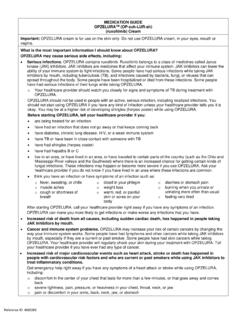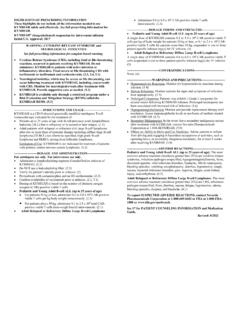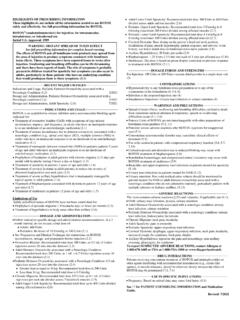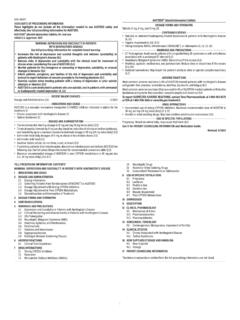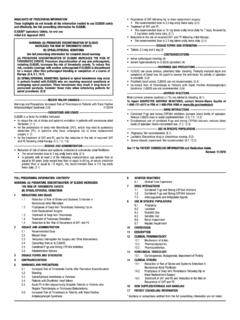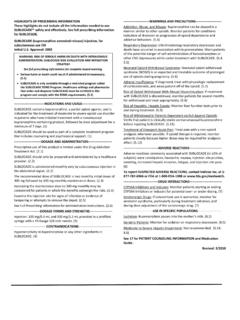Transcription of Prescribing Information | OPZELURA™ (ruxolitinib)
1 1 HIGHLIGHTS OF Prescribing Information These highlights do not include all the Information needed to use OPZELURA cream safely and effectively. See full Prescribing Information for OPZELURA cream. OPZELURA (ruxolitinib) cream, for topical use Initial Approval: 2011 WARNING: SERIOUS INFECTIONS, MORTALITY, MALIGNANCY, MAJOR ADVERSE CARDIOVASCULAR EVENTS (MACE), AND THROMBOSIS See full Prescribing Information for complete boxed warning. Serious infections leading to hospitalization or death, including tuberculosis and bacterial, invasive fungal, viral, and other opportunistic infections, have occurred in patients receiving Janus kinase inhibitors for inflammatory conditions. ( ) Higher rate of all-cause mortality, including sudden cardiovascular death have been observed in patients treated with Janus kinase inhibitors for inflammatory conditions.
2 ( ) Lymphoma and other malignancies have been observed in patients treated with Janus kinase inhibitors for inflammatory conditions. ( ) Higher rate of MACE ( including cardiovascular death, myocardial infarction, and stroke) has been observed in patients treated with Janus kinase inhibitors for inflammatory conditions. ( ) Thrombosis, including deep venous thrombosis, pulmonary embolism, and arterial thrombosis, some fatal, have occurred in patients treated with Janus kinase inhibitors for inflammatory conditions. ( ) _____ RECENT MAJOR CHANGES _____ boxed Warning 07/2022 Indications and Usage ( , ) 07/2022 Dosage and Administration ( , ) 07/2022 Warnings and Precautions ( , , , ) 07/2022 _____ INDICATIONS AND USAGE _____ OPZELURA is a Janus kinase (JAK) inhibitor indicated for: the topical short-term and non-continuous chronic treatment of mild to moderate atopic dermatitis in non-immunocompromised adult and pediatric patients 12 years of age and older whose disease is not adequately controlled with topical prescription therapies or when those therapies are not advisable.
3 ( ) the topical treatment of nonsegmental vitiligo in adult and pediatric patients 12 years of age and older. ( ) Limitations of Use Use of OPZELURA in combination with therapeutic biologics, other JAK inhibitors or potent immunosuppressants such as azathioprine or cyclosporine is not recommended. ( ) _____ DOSAGE AND ADMINISTRATION_____ Do not use more than one 60 gram tube per week or one 100 gram tube per 2 weeks. ( ) For topical use only. ( ) Not for intraocular, oral, or intravaginal use. ( ) Atopic Dermatitis o Apply a thin layer twice daily to affected areas of up to 20% body surface area. ( ) Nonsegmental Vitiligo o Apply a thin layer twice daily to affected areas of up to 10% body surface area. ( ) _____ DOSAGE FORMS AND STRENGTHS _____ Cream: ruxolitinib (3) _____ CONTRAINDICATIONS _____ None.
4 (4) _____ WARNINGS AND PRECAUTIONS _____ Serious Infections: Serious bacterial, mycobacterial, fungal and viral infections have occurred. Regularly monitor patients for infection and manage it promptly. ( ) Non-melanoma Skin Cancers. Basal cell and squamous cell carcinoma have occurred. Perform periodic skin examinations during treatment and following treatment as appropriate. ( ) Thrombosis. Thromboembolic events have occurred. ( ) Thrombocytopenia, Anemia, and Neutropenia: Thrombocytopenia, anemia, and neutropenia have occurred. Perform CBC monitoring as clinically indicated. ( ) _____ ADVERSE REACTIONS _____ In atopic dermatitis, the most common adverse reactions (incidence 1%) are nasopharyngitis, diarrhea, bronchitis, ear infection, eosinophil count increased, urticaria, folliculitis, tonsillitis, and rhinorrhea.
5 (6) In nonsegmental vitiligo, the most common adverse reactions (incidence 1%) are application site acne, application site pruritus, nasopharyngitis, headache, urinary tract infection, application site erythema, and pyrexia. (6) To report SUSPECTED ADVERSE REACTIONS, contact Incyte Corporation at 1-855-463-3463 or FDA at 1-800-FDA-1088 or ----------------------- USE IN SPECIFIC POPULATIONS ----------------------- Lactation: Advise not to breastfeed. ( ) See 17 for PATIENT COUNSELING Information and Medication Guide. Revised: 09/2022 FULL Prescribing Information : CONTENTS* WARNING: SERIOUS INFECTIONS, MORTALITY, MALIGNANCY, MAJOR ADVERSE CARDIOVASCULAR EVENTS, AND THROMBOSIS 1 INDICATIONS AND USAGE Atopic Dermatitis Nonsegmental Vitiligo Limitations of Use 2 DOSAGE AND ADMINISTRATION Important Administration Instructions Recommended Dosage for Atopic Dermatitis Recommended Dosage for Nonsegmental Vitiligo 3 DOSAGE FORMS AND STRENGTHS 4 CONTRAINDICATIONS 5 WARNINGS AND PRECAUTIONS Serious Infections Mortality Malignancy and Lymphoproliferative Disorders Major Adverse Cardiovascular Events (MACE)
6 Thrombosis Thrombocytopenia, Anemia, and Neutropenia Lipid Elevations 6 ADVERSE REACTIONS Clinical Trials Experience 7 DRUG INTERACTIONS 8 USE IN SPECIFIC POPULATIONS Pregnancy Lactation Pediatric Use Geriatric Use 11 DESCRIPTION 12 CLINICAL PHARMACOLOGY Mechanism of Action Pharmacodynamics Pharmacokinetics 13 NONCLINICAL TOXICOLOGY Carcinogenesis, Mutagenesis, Impairment of Fertility 14 CLINICAL STUDIES Atopic Dermatitis Nonsegmental Vitiligo 16 HOW SUPPLIED/STORAGE AND HANDLING 17 PATIENT COUNSELING Information *Sections or subsections omitted from the full Prescribing Information are not listed. 2 FULL Prescribing Information WARNING: SERIOUS INFECTIONS, MORTALITY, MALIGNANCY, MAJOR ADVERSE CARDIOVASCULAR EVENTS, AND THROMBOSIS SERIOUS INFECTIONS Patients treated with oral Janus kinase inhibitors for inflammatory conditions are at risk for developing serious infections that may lead to hospitalization or death [see Warnings and Precautions ( ) and Adverse Reactions ( )].
7 Reported infections include: Active tuberculosis, which may present with pulmonary or extrapulmonary disease. Invasive fungal infections, including cryptococcosis, and pneumocystosis. Bacterial, viral, including herpes zoster, and other infections due to opportunistic pathogens. Avoid use of OPZELURA in patients with an active, serious infection, including localized infections. If a serious infection develops, interrupt OPZELURA until the infection is controlled. The risks and benefits of treatment with OPZELURA should be carefully considered prior to initiating therapy in patients with chronic or recurrent infection. Patients should be closely monitored for the development of signs and symptoms of infection during and after treatment with OPZELURA [see Warnings and Precautions ( )].
8 MORTALITY In a large, randomized, postmarketing safety study in rheumatoid arthritis (RA) patients 50 years of age and older with at least one cardiovascular risk factor comparing an oral JAK inhibitor to tumor necrosis factor (TNF) blocker treatment, a higher rate of all-cause mortality, including sudden cardiovascular death, was observed with the JAK inhibitor [see Warnings and Precautions ( )]. MALIGNANCIES Malignancies were reported in patients treated with OPZELURA. Lymphoma and other malignancies have been observed in patients receiving JAK inhibitors used to treat inflammatory conditions. In RA patients treated with an oral JAK inhibitor, a higher rate of malignancies (excluding non-melanoma skin cancer (NMSC)) was observed when compared with TNF blockers. Patients who are current or past smokers are at additional increased risk [see Warnings and Precautions ( )].
9 3 MAJOR ADVERSE CARDIOVASCULAR EVENTS (MACE) In RA patients 50 years of age and older with at least one cardiovascular risk factor treated with an oral JAK inhibitor, a higher rate of major adverse cardiovascular events (MACE) (defined as cardiovascular death, myocardial infarction, and stroke), was observed when compared with TNF blockers. Patients who are current or past smokers are at additional increased risk. Discontinue OPZELURA in patients who have experienced a myocardial infarction or stroke [see Warnings and Precautions ( )]. THROMBOSIS Thromboembolic events were observed in trials with OPZELURA. Thrombosis, including pulmonary embolism (PE), deep venous thrombosis (DVT), and arterial thrombosis have been reported in patients receiving JAK inhibitors used to treat inflammatory conditions.
10 Many of these adverse reactions were serious and some resulted in death. In RA patients 50 years of age and older with at least one cardiovascular risk factor treated with an oral JAK inhibitor, a higher rate of thrombosis was observed when compared with TNF blockers. Avoid OPZELURA in patients at risk. If symptoms of thrombosis occur, discontinue OPZELURA and treat appropriately [see Warnings and Precautions ( )]. 1 INDICATIONS AND USAGE Atopic Dermatitis OPZELURA is indicated for the topical short-term and non-continuous chronic treatment of mild to moderate atopic dermatitis in non-immunocompromised adult and pediatric patients 12 years of age and older whose disease is not adequately controlled with topical prescription therapies or when those therapies are not advisable. Nonsegmental Vitiligo OPZELURA is indicated for the topical treatment of nonsegmental vitiligo in adult and pediatric patients 12 years of age and older.
